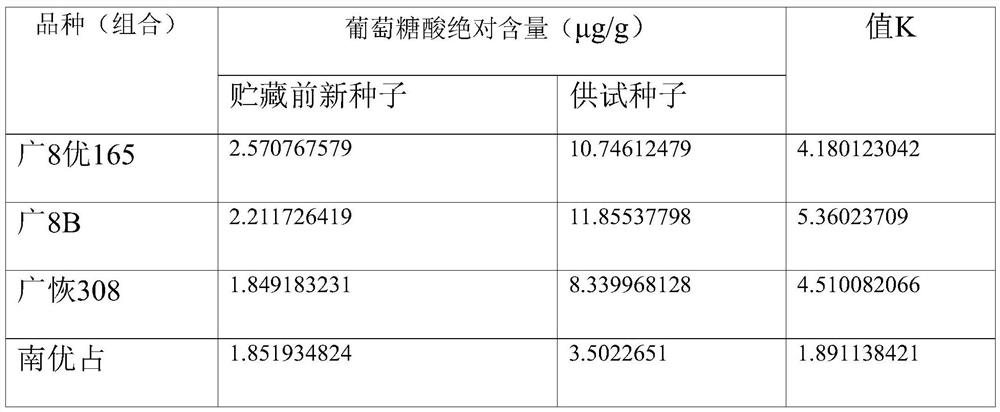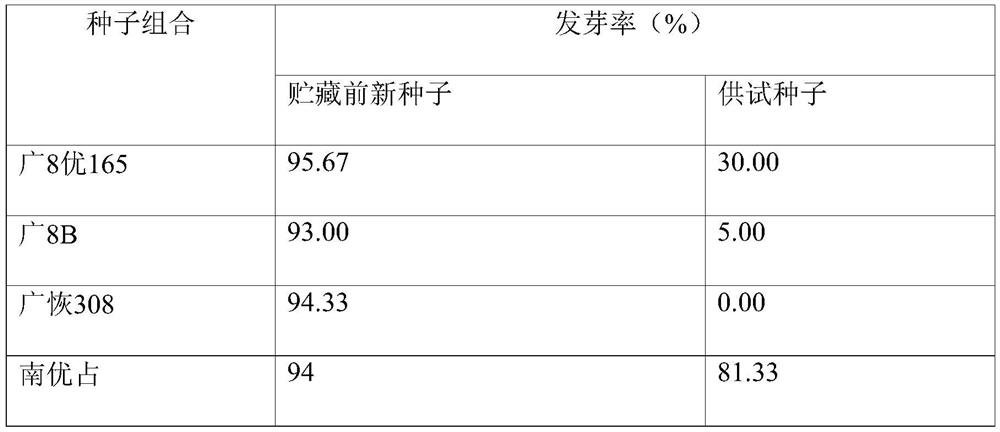Method for judging deteriorated rice seeds based on gluconic acid content change ratio
A technology for gluconic acid and rice seeds, which is applied to measurement devices, instruments, scientific instruments, etc., can solve the problems of many factors of data change, time-consuming and labor-intensive, etc., so as to overcome time-consuming and labor-intensive, save seeds, and improve the discrimination efficiency. Effect
- Summary
- Abstract
- Description
- Claims
- Application Information
AI Technical Summary
Problems solved by technology
Method used
Image
Examples
Embodiment 1
[0045] Hybrid rice combinations such as QY3618, B3Y998, IIY998, and QY998 were selected as experimental materials, and the harvested seeds were naturally aged for 2 years.
[0046] Afterwards, a certain amount of above-mentioned rice seeds is taken, and its germination rate is measured according to the "Method for Determination of Germination Rate of Rice Seeds" (GB / T 3543); at the same time, the extraction of the above-mentioned gluconic acid and the quantitative determination method of the relative content are carried out for the determination of the seed metabolites. The extraction and quantitative determination of gluconic acid calculated the ratio of gluconic acid in rice seeds before and after storage, which is recorded as K1 (Table 1), wherein the content of the seed metabolite gluconic acid refers to the average content of gluconic acid in the whole seed, that is, the The content of the embryo and endosperm mixture.
[0047] It can be seen from Table 1 that after 2 yea...
Embodiment 2
[0057] The 368 series hybrid rice combination was selected as the experimental material, and the harvested seeds were naturally aged for 2 years.
[0058] Get a certain amount of above-mentioned rice seeds afterwards, carry out germination rate measurement to it according to " rice seed germination rate determination method " (GB / T3543); Simultaneously, carry out seed metabolite glucose by the extraction of above-mentioned gluconic acid and the quantitative determination method of relative content. The acid was extracted and quantitatively determined, and the ratio of gluconic acid in rice seeds before and after storage was calculated, which was recorded as K1 (Table 2).
[0059] It can be seen from Table 2 that after 2 years of natural aging of the 368 series hybrid rice seeds tested, the germination rate all decreased. %, for unqualified seeds. Also as can be seen from Table 2, along with the reduction of natural aging seed germination rate, the gluconic acid content in all...
Embodiment 3
[0067] Take Guang 8 You 165, Guang 8B and Guang Hui 308 whose natural aging treatment time is 2 years, and Nanyouzhan whose natural aging treatment time is 1.5 years. The metabolite gluconic acid was extracted and quantitatively measured, and the ratio of gluconic acid in rice seeds before and after storage was calculated, which was recorded as K1: the K1 value of Guang 8 You 165 was 3.156215678, the K1 value of Guang 8B was 3.787893221, and the K1 value of Guanghui 308 was 2.255632878, Nan Youzhan's K1 value is 3.117867776.
[0068] In the natural storage of rice seeds, the old seeds of the combination of Guang 8 You 165, Guang 8B, Guang Hui 308 and Nan You Zhan after a certain period of natural storage and the same four new storage) as the material, and then a certain amount of the above-mentioned rice seeds was taken to carry out the experiment.
[0069] The first step: determine the absolute content of gluconic acid in the seeds and calculate the K value (Table 3). The a...
PUM
 Login to View More
Login to View More Abstract
Description
Claims
Application Information
 Login to View More
Login to View More - R&D
- Intellectual Property
- Life Sciences
- Materials
- Tech Scout
- Unparalleled Data Quality
- Higher Quality Content
- 60% Fewer Hallucinations
Browse by: Latest US Patents, China's latest patents, Technical Efficacy Thesaurus, Application Domain, Technology Topic, Popular Technical Reports.
© 2025 PatSnap. All rights reserved.Legal|Privacy policy|Modern Slavery Act Transparency Statement|Sitemap|About US| Contact US: help@patsnap.com


